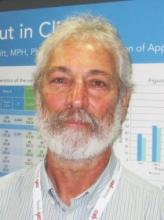SAN DIEGO – Team-based care – a cornerstone of redesigning clinics into patient-centered medical homes – won’t necessarily decrease physician burnout, according to researchers from Allina Health, a large Midwestern integrated health system based in Minneapolis.
Among other benefits, team-based care is supposed to decrease the workload on physicians – a major driver of doctor burnout – by adding a few extra hands to help with paperwork, phone calls, and other tasks.
It didn’t seem to do that, though, in the study. Investigators administered the Maslach Burnout Inventory to doctors, mid-level providers, clinical assistants, and other staff at four community primary care clinics as they switched to a team-care approach, with three clinical assistants for every two doctors, and at 3, 6, and 12 months thereafter.
The findings were compared with results from Maslach surveys administered at the same time intervals to physicians and others at four community primary care clinics that stuck to the traditional one physician/one clinical assistant staffing model. Both rural and suburban clinics run by Allina Health participated in the study.
"Much to our chagrin, we found no significant impact of team care on burnout prevalence and severity" at any of the survey points. "There was a slight trend early [for doctors] that degraded over time, and there was a slight [favorable] trend among clinical assistants ... but nothing statistically significant," said lead investigator Dr. William Spinelli, a family practitioner in Hastings, Minn.
Response rates varied at each time interval, with 60-96 providers – physicians, physician assistants, and nurse practitioners – filling out the Maslach at each survey point, split roughly equally among team care and control clinics.
At baseline, about 35% (17) of providers at team-care clinics hit the Maslach mark for burnout as did about 40% (19) of providers at control-group clinics. That rose to about 50% (30) in both settings at 3 months, and stayed at about 50% (17) in the control clinics but dropped back to about 35% (12) in the team-care clinics at month 6. At 1 year, burnout among team-care providers remained at about 35% (11), but had fallen to 30% (10) among control-clinic providers. The differences were not statistically significant.
Overall, women providers were slightly less burned out than men, but gender offered no protective effect on further analysis (for example, odds ratio at the 12-month survey point 1.12; 95% confidence interval 0.56-2.42; P = 0.75). There did, however, seem to be a protective effect for "decreasing from full-time [36 hours of direct outpatient contact per week, for instance] to part-time work, which is interesting because there are data in the literature suggesting there is no difference," Dr. Spinelli said.
Overall, 630 providers, clinical assistants, and other staff members, a category that included, for example, licensed practical nurses and x-ray technicians, participated in the study; they completed 1,405 electronic surveys.
Across the three job categories in both settings, most of the study participants were white, female, and 31-60 years old. Full-time status at each of the study points ranged from 37.8% to 50.8%, and most participants had been on the job for more than 4 years.
Burnout prevalence was higher among doctors than among clinical assistants and other staffers. Clinical assistant burnout prevalence hovered at about 25% in both settings throughout the study, and at about 30% for other workers. Burnout was less common, but not significantly less, in both job categories in team-care clinics.
"When you begin to look at design initiatives focused on the providers, we also have to ask if those initiatives are going to benefit other workers. We have another study" in process "that suggests there is a differential set of contributing factors for burnout; for providers, it’s definitely workload, for [others] it turns out that workload is far less of an issue than [are] things such as fairness and rewards. There’s not going to be a one size fits all solution" for burnout in the clinic, Dr. Spinelli said.
National data suggests burnout approaches 46% for all U.S. physicians, and about 50% for family physicians.
The Maslach Burnout Inventory is a 22-question measure of emotional exhaustion, cynicism, depersonalization, and other issues. Burnout is defined as meeting certain cut-points on such problems. Dr. Spinelli has no disclosures.


